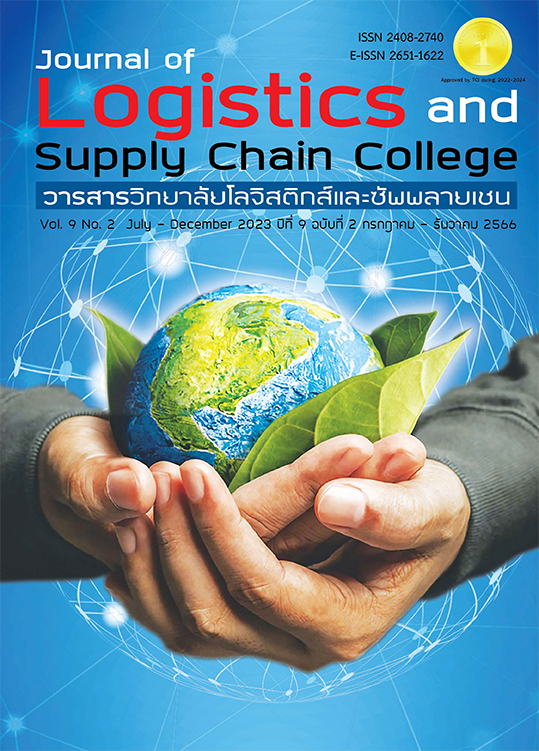The Study Efficiency of Soft Drink Warehouse Administration with the Warehouse Management System WMS Software
DOI:
https://doi.org/10.53848/jlscc.v9i2.261199Keywords:
Warehouse efficiency, Warehouse management, Soft drink products, WMSAbstract
This research aims to 1) to study the efficiency of soft drink warehouse management with WMS software; and 2) To study the influence of soft drinks warehouse management with WMS software on the efficiency of warehouse operations. by using a mixed research model between quantitative research and qualitative research. The population used in the research were 507 employees of warehouse operations and distribution operations. Data were collected by questionnaires from a sample of 203 people and in-depth interviews of 12 people. The research instruments were questionnaires and interview forms. The quality of the instrument was examined with content reliability IOC = 0.84 and confidence value = 0.91. Data were analyzed using descriptive statistics and Test hypothesis with multiple regression analysis statistics. The finding found that 1) Efficiency of soft drink warehouse management with WMS software found that The overall picture is at the highest level. When considering each aspect, it was found that The highest mean is the accuracy dimension (
= 4.60) is the storage of goods. Helps to classify products correctly, Next is the time dimension (
= 4.58) which is the storage of goods. Helps to store products faster and the lowest mean is the wastage dimension (
= 4.55) is the storage of goods Reduces wasted time. 2) The influence of soft drinks warehouse management with WMS software on the efficiency of warehouse operations found that Receiving goods, storing goods Manage storage areas and product arrangement This function influences the efficiency of warehouse operations. statistically significant at 0.01 and 0.05 levels while the payment of the product has no effect Therefore, to use the research results to the maximum benefit, practitioners must understand the correct workflow.
References
กฤชชัย อนรรฆมณี. (2563). ส่งมอบตรงเวลาและครบจำนวน ปัจจัยของการพัฒนาผลิตภาพ. ค้นเมื่อ 20 กรกฎาคม 2564, จาก: https://www.bangkokbiznews.com /blogs/columnist/124007.
จุฑาทิพย์ ลีลาธนาพิพัฒน์ และธีระวัฒน์ จันทึก. (2561). การจัดการสินค้าคงคลังอย่างมือ. Veridian E-Journal,Silpakorn University ฉบับภาษาไทยสาขามนุษยศาสตร์สังคมศาสตร์และศิลปะ, 11(1),1-16.
คำนาย อภิปรัชญาสกุล. (2559). การจัดการพื้นที่คลังสินค้า. พิมพ์ครั้งที่ 2. กรุงเทพมหานคร: บริษัท โฟกัส มีเดีย แอนด์ พับลิชชิ่ง จำกัด.
ชนกานต์ สมานมิตร. (2558). ระบบพัฒนาประสิทธิภาพการทำงาน. กรุงเทพฯ: กรมการฝึกหัดครู กระทรวงศึกษาธิการ.
ฐณวัฒน์ วุฒิอิสราพัชร์. (2563). การจัดการสินค้ายุคใหม่ให้แข็งแกร่ง. ค้นเมื่อ 6 สิงหาคม 2564, จาก:https://www.aobrom.com/postdetail._2229.
ณภัสณรรฑ์ วงษ์สมาจารย์. (2560). การปรับปรุงแผนผังคลังสินค้าสำเร็จรูปเพื่อลดระยะทางรวมของการเคลื่อนไหวของสินค้า กรณีศึกษา โรงงานผลิตเหล็กหล่อ. สารนิพนธ์ปริญญาวิศวกรรมศาสตรมหาบัณฑิต สาขาวิชาการพัฒนางานอุตสาหกรรม, มหาวิทยาลัยธรรมศาสตร์.
ธนิต โสรัตน์. (2562). การจัดการคลังสินค้ายุคใหม่. ค้นเมื่อ 22 พฤศจิกายน 2564, จาก: http://www.logisticsthai club.com/ index. php?mo=3&art=280061.
ธันยนันท์ ทองบุญตา. (2562). เพิ่มประสิทธิภาพการทำงานด้วยการเสริมแรงทางลบ. วารสารมนุษยศาสตร์และสังคมศาสตร์ มหาวิทยาลัยราชพฤกษ์. 5(3), 14-27.
ธิญาดา ใจใหมคร้าม. (2558). การเพิ่มประสิทธิภาพการจัดการคลังสินค้า กรณีศึกษาคลังสินค้า 2 ราษฎร์บูรณะกรุงเทพมหานคร องค์การคลังสินค้า. สารนิพนธ์ปริญญาบริหารธุรกิจมหาบัณฑิต, มหาวิทยาลัยกรุงเทพ.
นลพรรณ บุญฤทธ. (2558). ปัจจัยที่มีผลต่อประสิทธิภาพในการปฏิบัติงานของบุคลากร องค์การบริหารส่วนจังหวัดชลบุรี. ปริญญาบริหารธุรกิจมหาบัณฑิต สาขาวิชาการจัดการสาธารณะ, วิทยาลัยพาณิชยศาสตร์ มหาวิทยาลัยบูรพา.
รวมพล จันทศาสตร์ และอังกูร ลาภเนตร. (2562). ปัจจัยที่ส่งผลต่อการขนส่งและการคลังสินค้าเพื่อลดความสูญเปล่าและเพิ่มคุณค่า. วารสารบัณฑิตศึกษามหาจุฬาขอนแก่น, 6(1), 403-418
ศุจิกา บุญฤทธิ์. (2556). การจัดลำดับความสำคัญตัวชี้วัดประสิทธิภาพคลังสินค้าด้วยเทคนิคระดับชั้นเชิงวิเคราะห์ฟัซซี่. รายงานการวิจัยคณะวิศวกรรมศาสตร์มหาวิทยาลัยธรรมศาสตร์.
สภาพัฒนาการเศรษฐกิจและสังคมแห่งชาติ. (2564). แผนพัฒนาเศรษฐกิจและสังคมแห่งชาติ ฉบับที่สิบสอง พ.ศ. 2560 – 2564. ค้นเมื่อ 22 กันยายน 2564, จาก: https://www.nesdc.go.th/main.php? filename=index.
สุภา จิรวัฒนานนท์. (2562). อิทธิพลของเทคโนโลยีต่อประสิทธิภาพการบริหารจัดการคลังสินค้าในธุรกิจค้าปลีกสมัย ใหม่. วารสารเกษมบัณฑิต, 20(2), 42-55.
สุรศักดิ์ พรบรรเจิดกุล. (2563). บริหารคลังสินค้าให้มีประสิทธิภาพและทำกำไรทันที. พิมพ์ครั้งที่ 1. กรุงเทพฯ:บริษัท กู๊ดเฮด พริ้นท์ติ้ง แอนด์ แพคเกจจิ้งกรุ๊ป จำกัด.
สมพิศ สุขแสน. (2556). เทคนิคการทำงานให้มีประสิทธิภาพ. ค้นเมื่อ 4 พฤษภาคม 2564, จาก:https://bongkotsakorn.Wordpress.com/2013/06/06/ เทคนิคการทำงานให้ประสบความสำเร็จ.
อลงกต ใหม่น้อย. (2560). การเพิ่มประสิทธิภาพขององค์การ. ค้นเมื่อ 10 ตุลาคม 2564, จาก: https://sites. google.com/site/mralongkotmainoy/kar-pheim-prasiththiphaph-khxng-Xngkhkar.
โอฬาร กิตติธีรพรชัย. (2561). คลังสินค้าและการจัดการคลังสินค้า. พิมพ์ครั้งที่ 1. กรุงเทพฯ: ภาควิชาวิศกรรมอุตสาหการ คณะวิศวกรรมศาสตร์ จุฬาลงกรณ์มหาวิทยาลัย.
อัจจิมา เชิดชม และปณิธาน พีรพัฒนา. (2562). การปรับปรุงระบบบริหารจัดการคลังสินค้าเพื่อกำหนดตำแหน่งในการจัดเก็บสินค้า: กรณีศึกษาศูนย์กระจายสินค้าในภาคตะวันออกเฉียงเหนือ. รายงานการวิจัยคณะวิศวกรรมศาสตร์ มหาวิทยาลัยขอนแก่น.
Yamane, Taro. (1973). Statistics: An Introductory Analysis. 3rd. New York: Harper and Row Publications.



